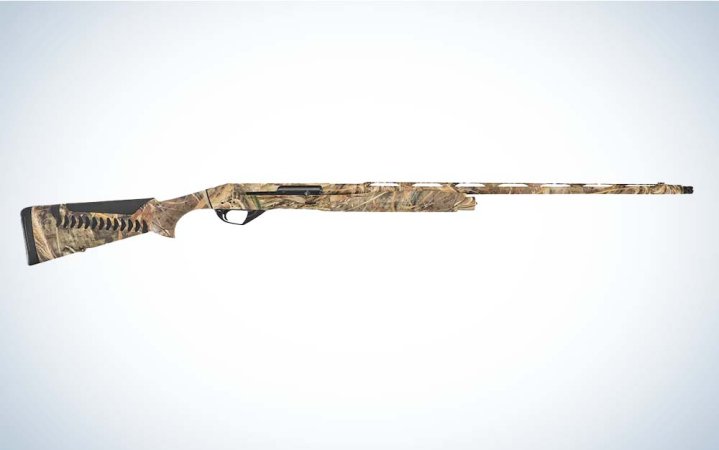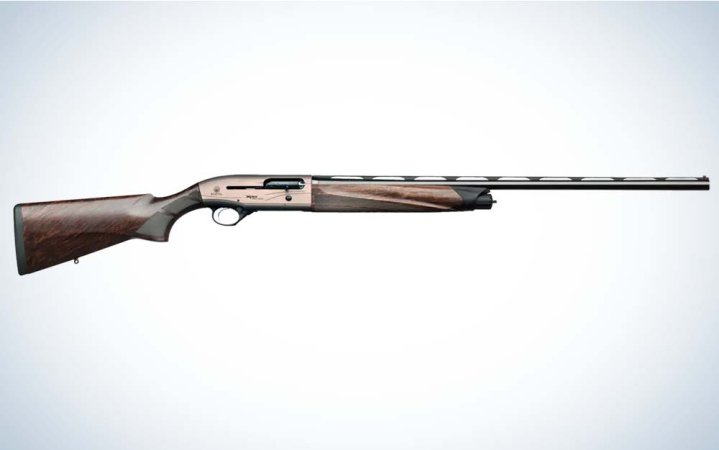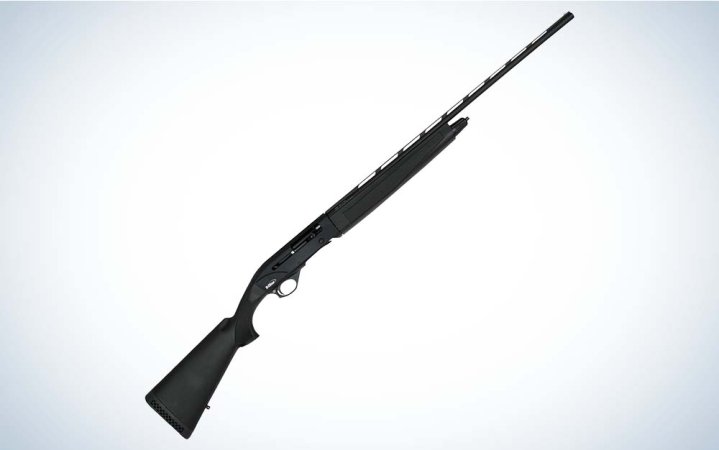We may earn revenue from the products available on this page and participate in affiliate programs. Learn More ›
Shotgun trends flow like the tides, they’re in and out depending on ammo performance (and availability), plus the advancement of the smoothbores themselves. Right now, sub-gauges are the rage for wingshooters, fueled by renewed interest in the 28-gauge and the diminutive .410-bore. Why? They are all effective on wild gamebirds at reasonable distances with the right shotshell, they’re light, and don’t punish you the way an inertia-driven 12-gauge paired with a 3-inch 1 5/8-ounce load of bismuth will. Here is a rundown of some of the best auto-loading sub-gauge shotguns whether you pursue ducks, geese, upland birds, or enjoy weekend rounds of skeet. There are a couple of old autos that made the list, but a majority of them can be bought off the shelf at your local gun shop.
Remington 11-48 28-Gauge and .410-Bore

Remington’s inertia-driven 11-48 (1948 is the year it was developed, but it wasn’t introduced until 1952) was the first successful 28-gauge and .410 autoloader. Remington built the Model 11 long recoil shotgun on license from Browning, essentially an A-5 replica. Post World War Two manufacturing ushered in stamped steel parts, a cheaper way to make guns in all configurations. That’s the reason Remington shotguns look very similar to one another—compare an 870 to an 1100 side by side—and have multiple interchangeable parts.
Remington introduced the 28-gauge 11-48 in 1952. My grandfather and uncle each hunted quail with them. The 28 is a wonderful upland auto, easy to carry, and packs plenty of gun for bobwhites. They shot improved cylinder choked barrels in combination with No. 9 lead shot, which produced deadly patterns to 30 yards.
The .410 11-48 was primarily a skeet gun. As the first semi-auto .410, skeet shooters that preferred autos only had the 11-48 to turn to, so Remington built a vent ribbed skeet model that remains a collector’s item. Both the .410 and the 28 are not easy to come by as production of both was limited. You can still track one down if you look hard enough, just be prepared to pay at least $1,200 if it’s in decent condition.
Remington 1100 Sporting 28-Gauge

Remington’s gas-operated 1100 changed the semi-auto shotgun game when it debuted in 1963. The 1100 looks like the 11-48, which was eventually retired in favor of the new 1100 model, using the same rounded receiver. But the 1100 was more reliable. The 1100 did have cycling issues, however, mostly due to shooters not keeping it clean or failing to replace worn o-rings that were needed to properly operate the action. The 1100’s reduction in recoil helped Remington sell over 4 million and counting (RemArms has plans to continue producing the gun). Plus, like so many Remington shotguns, Big Green engineered the 1100 to fit a wide assortment of shooters, another reason why it became such a popular clays gun.
The sweet spot in the 1100 Sporting line was the 28-gauge. These guns were designed as target guns but make a wonderful upland option as well. RemArms, the most recent company to purchase Remington out of bankruptcy, isn’t building the 28 at this time, but you can get it in .410. There are also used 28s on the market, but they tend to be pricey ($1,500).
The wood furniture on the old 1100s is some of the best quality mahogany and walnut I have seen on a Remington production gun. Remington 1100s also include gloss blue metal finishes, vent rib barrels, and white bead front sight. If you can find an 1100 Premiere Sporting (made from 2008 to 2011), snatch it up. You’ll recognize it by the nickel-plated receiver. The gun also came with four aftermarket Briley extended chokes.
Benelli Super Black Eagle 28-Gauge

The Super Black Eagle series was coveted by an overwhelming number of duck hunters because it was the first 12-gauge auto-loader that could shoot 3½-inch shotshells. That was 30 years ago, and as shotshell technology has improved the chamberings for SBE’s are getting smaller. In addition to the 3½-inch model, you can now purchase the Benelli in a 3-inch 12- and 20-gauge variant, plus the 28, which is new for this year. Chambered for 3-inch shells, it’s one of the few 28s that can handle such a load (most 28s are chambered for 2¾-inch shotshells).
Benelli offers the 28 in black, Realtree Max-5, Mossy Oak Bottomland, and Optidfade Timber, making the gun at home in the marsh, flooded fields, and green tree reservoirs mallards love. The SBE sub-gauge has the same barrel lengths (26- and 28-inch) as the 12-gauge model and is the same overall length, just lighter at 5.5 pounds.
Beretta A400 Xplor Action 28-Gauge
Gas guns are Beretta’s specialty in their semi-auto lineup. They have built some of the best, including the 302 and 303 in the late 1970s and early ’80s. Then came the legendary 390 and 391 series that set new standards in gas autoloader reliability. Today, the A400 lineup includes some of the finest gas auto-loaders in the world.
The Xplor Action 28-gauge uses Beretta’s Blink system, which the Italian gunmaker claims allows shooters to fire four rounds in less than a second. The system’s speed lies in the split-ring valve that seals tight, making for a more efficient and cleaner gas transfer, creating less fouling in the chamber. The gun spreads recoil out remarkably well even though it’s a fast-cycling auto. Most guns that carry such labels are hell on your shoulder. Reliability is also a staple of this platform, but you must keep the auto-loader clean. Even the best gas systems require a field strip and wipe down of the gun after in-field abuse.
The Xplor Action is a looker with a bronze-colored receiver, blued barrel, and walnut stock. It doesn’t have the exterior durability of the SBE III, but a few chips and dings won’t stop the A400 from running. It’s available in 26- or 28-inch barrel lengths with five chokes included.
TriStar Viper G2 .410
TriStar’s slogan is “The Value Experts” and it’s an accurate claim. The entire line of TriStar guns has gained momentum over the last decade because they are a good value for the money. Made in Turkey by Armsan and imported to Kansas City, the G2 gas autoloader lineup is available in every legal gauge but 10, my favorite being the .410.
In .410 alone, Viper G2’s come in Bronze (a similar look to the Beretta Xplor Action), Wood, Synthetic (black finish), Camo (Realtree Edge), and a pistol-gripped turkey model with a bronzed receiver and Mossy Oak Bottomland stock topped with an optics rail. That’s a wide shotgun selection in .410 and all are priced below $1,000. The .410 G2 weighs under 6 pounds and three chokes (IC, M, F) are included with each model.
You can use the G2for skeet, upland, waterfowl, turkeys, and a variety of small game. Outdoor Life senior editor, Joe Genzel, has shot the Bronze model extensively on skeet, doves, and squirrels. He reported that the gun is incredibly accurate (when you’re shooting well). He has busted upwards of 20 clays per round on skeet with the G2; and scored in the single digits—.410s are fickle range guns. It’s a light carrying gun (5.8 pounds) in the squirrel woods, critical when you’re covering a lot of ground behind a high-energy wolf dog like Genzel has.
The only downside to this gun in my experience has been the stock coming loose from the receiver after running a few hundred rounds through it. To tighten in up, you must remove the buttpad and tighten the nut that holds the stock in place.
Best .410 Target and Game Load Shotshells
There are many lead skeet loads to choose from if you shoot a .410, but I am a proponent of using No. 9 shot in a 2½-inch, ½-ounce shotshell. It offers the shooter almost 300 pellets, which means more margin for error than a No. 8 (205 pellets) or No. 7½ (175 pellets) in the same charge weight. For upland bird options, consider stepping up to a 3-inch shotshell with either an 11/16- or ¾-ounce payload in 4s, 5s, or 6s. There’s not much of gap in pellet counts between these two charge weights—for instance an 11/16-ounce No. 6 has 155 and a ¾-ounce 6 has 169—so whichever load you can find will do.
If you’re duck hunting, there are 3-inch bismuth, tungsten, and steel loads at your disposal, but premium non-toxics are the route to go in order to avoid crippling birds. Steel .410 loads can kill ducks in the timber or early-season teal, but bismuth loads, like Boss, RST, or Hevi-Bismuth (safe to shoot in fixed choked shotguns with thin steel barrels) are denser (9.6 g/cc compared to 7.8 g/cc) and thus more effective. Hevi-Shot makes a tungsten-iron shotshell with a pellet density of 12 g/cc, and straight tungsten offerings are even better as the pellets carry a density of 18.1 g/cc, almost double that of bismuth. But few manufacturers make a .410 TSS waterfowl load. Federal Premium’s Custom Shop will load 3-inch 7s or 9s for you and Apex will occasional have shells available, but outside of that, you will likely need to turn to hand loads or fork over $45 a for a box of just five TSS turkey loads.




